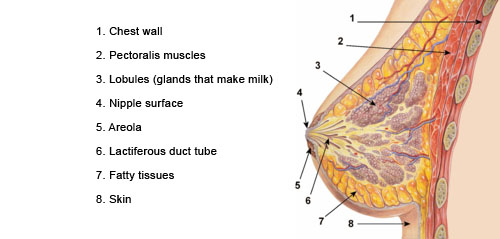A generic and scientific definition for what is breast cancer can be given as, “A malignant tumor (usually a collection of cancer cells) arising from the cells of the breast”. Specifically, the term breast cancer explains us all. However, there are many terminologies that we are unaware of and this ignorance usually leads to getting infected with this deadly disease. In this article, it would be my approach to educated you about exactly what breast cancer is, how is one prone to this disease, breast cancer symptoms, signs, stages, types, risk factors, diagnosis, preventive information and treatment options.
Breast cancer (b.cancer) primarily starts off in the inner lining of the milk ducts or the lobules that supply them with milk. The breast cancer that gets started off in the lobules is known as the lobular carcinoma whereas the one which is developed in the ducts is known as the ductal carcinoma. Breast cancer is believed to be one of the most common invasive cancers in women. The below given image will give you a rough idea about what the breast comprises of and what leads to breast cancer.

The female breast is made up of the milk producing glands known as lobules, several tiny tubes known as ducts that carry milk from lobules to the nipple and stroma (which comprises of blood vessels, fatty tissues & connective tissues surrounding the ducts and lobules, and lymphatic vessels). Considering b.cancer, the tumor begins to grow in the cells that line the ducts and is known as ductal cancer. Apart from ductal cancer, the tumor may also begin in cells that line the lobules and is named as the lobular cancer. Breast cancer can also start in other tissues but is a very rare case.
The question: what is breast cancer, can be answered completely only when we understand the two different types of this cancer and the difference between it. Following are the two major criteria in which breast cancer gets primarily distinguished:
Non-invasive Breast Cancer: In this type of breast cancer, the cancer remains in its place of origin. This type is usually considered to be the pre-cancerous stage where the abnormal cells remain in a specific location, however, eventually may lead into invasive breast cancer.
Invasive Breast Cancer: This type of cancer occurs when the cancerous cells break out from inside the lobules or ducts and invade the nearby tissues. This invasion further lead the abnormal cells to the lymph nodes, eventually making their way to other organs including bones, lungs or even the liver. The invasive cancer if not treated in early stages can make the cancerous cells travel through the bloodstream or the lymphatic system to other parts of the body.
Many a times, we do not realize of getting infected by this disease until it’s too late. Usually, the signs and symptoms of breast cancer include severe headache or a rash or swelling. However, we do not recognize this to be a symptom for breast cancer and most of the times take pain killers or other medications to get relieved. Hence, women must be very particular with their health and take proper medical consultations whenever they feel abnormal. Following is the list of various signs and symptoms of breast cancer:
- One of the most primary symptoms of breast cancer includes thickened tissues or formation of lump in the women’s breast
- Severe pain in armpits or breast which is not related to menstrual period and continues even after the cycle
- A rash around any or both of the nipples
- Formation of lump in any of the armpits
- Clear or bloody fluid discharge that leaks out of the nipple
- Sudden change in the size and shape of the breast
- The breast or nipple skin start to peel, scale, or flake
Till today, no firm cause of breast cancer has been detected by medical science. However, some of the common causes amongst breast cancer patients include age factors, genetics, a history of breast cancer, dense breast tissues, obesity, height, estrogen exposure, excessive alcohol consumption, radiation exposure, etc.
Hope this article has guided you on what is breast cancer. To know more about the causes, symptoms, treatments, and preventive measures look for the respective tabs in the menu bar.
Read more:

